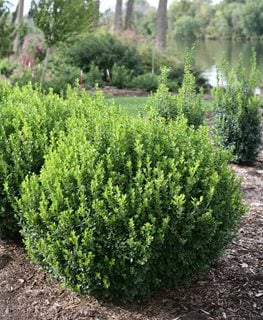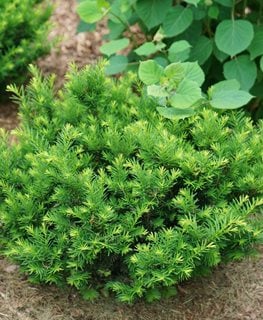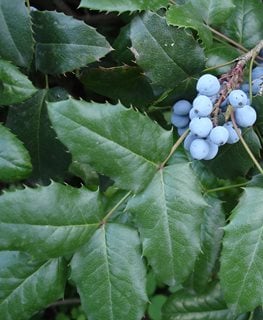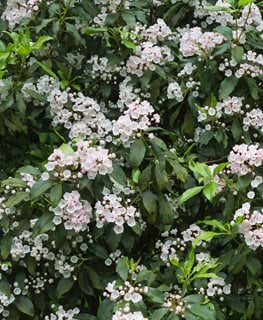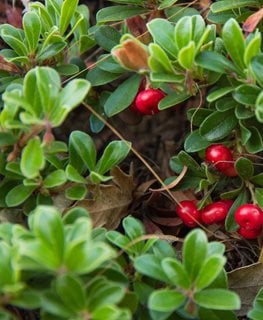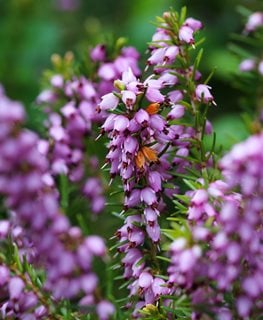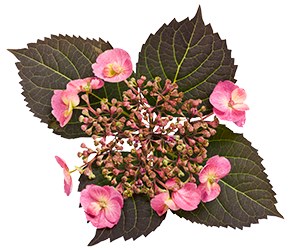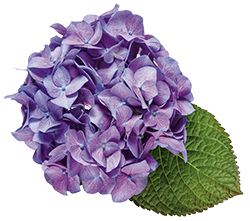Top 15 Evergreen Shrubs for Your Garden
Bring life to your landscape with these 15 bushes that keep their leaves all yearEvergreen shrubs bring life to dreary winter landscapes with their lush greenery. Like coniferous evergreens, evergreen shrubs create an everlasting framework for seasonal garden plantings. Some spring-flowering evergreen shrubs also produce attractive colorful berries in the fall, broadening their year-round appeal.
On this page: Evergreen Shrubs | Winter Protection for Evergreens
On this page:
EVERGREEN SHRUBS
Sprinter® boxwood (Buxus microphylla). Photo: Proven Winners.
BOXWOOD (Buxus spp. and hybrids)
Zones: 5-9 for most, a few hardy to Zone 4Exposure: Sun or shade
Mature size: 2 to 4 feet tall and wide for most, some to 8 feet
Probably the best evergreen for shaping and pruning, which is why they are often the gardener’s choice for creating formal hedges, borders, and even topiaries. Sprinter® (pictured) is a fast grower that will fill in more quickly than other varieties.
Learn more about growing boxwoods.
Fluffy® arborvitae. Photo: Proven Winners.
ARBORVITAE (Thuja spp.)
Zones: 2-8, depending on varietyExposure: Full sun
Mature size: Varies widely, from low growers at 3 feet tall to large trees in excess of 70 feet.
Fast-growing, easy-care evergreens that can be planted as privacy screens and hedges. Planted in a row, their dense foliage will fill in to create a screen in just a year or two.
Learn more about growing arborvitae shrubs and trees.
Dandy Man® Purple evergreen rhododendron. Photo: Proven Winners.
AZALEA & RHODODENDRON (Rhododendron spp.)
Zones: 3-9, depending on varietyExposure: Full sun to partial shade, depending on variety and location
Mature size: 1 to 8 feet tall and wide, depending on variety
Bloom time: Peak bloom generally mid-spring, some as late as July; reblooming varieties with a second flush in late summer.
Azaleas are types of rhododendrons. There are thousands of varieties, including both evergreen and deciduous.
Learn more about growing rhododendrons and azaleas.
YEW (Taxus spp.)
Zones: Varies, 3-10Exposure: Full sun to shade
Mature size: Varies by cultivar; 3 to 20 feet tall, 1 to 10 feet wide.
Popular for privacy hedges, foundation plantings, and topiaries. These low-maintenance plants grow in all light conditions, but do require excellent drainage. Be careful, as yews are toxic to humans and animals.
Gin Fizz® (Juniperus chinensis). Photo: Proven Winners.
JUNIPER (Juniperus spp.)
Zones: Varies, 4-9Exposure: Full sun
Mature size: Varies by cultivar; smaller varieties 2 feet tall, 3 to 4 feet wide; larger varieties to over 25 feet tall and 7 to 10 feet wide.
Popular for four-season interest, junipers are also deer resistant. Vaieties range from ground-hugging bushes to towering specimens. Use juniper to add strong structure to your garden, cover a slope or create a hedge for privacy.
Learn more about growing juniper shrubs and trees.
OREGON GRAPE (Mahonia aquifolium)
Zones: 5-8Exposure: Partial to full shade
Mature size: 3 to 6 feet tall with a spread of 2 to 5 feet
Bloom time: Spring
This native of western North America will provide color throughout all four seasons, producing cheery yellow flowers in spring, edible grapelike clusters of dark blue berries in late summer, and shiny green leaves that turn bronze red in the fall.
Castle Spire® blue holly (Ilex × meserveae). Photo: Proven Winners.
BLUE HOLLY (Ilex × meserveae)
Zones: 5-7Exposure: Partial to full sun
Mature size: Varies by cultivar; up to 6 to 10 feet tall, 3 to 4 feet wide
Bloom time: Spring
This broad, upright holly is sought after for its glossy blue-green leaves, which provide year-round interest. Tiny white flowers in spring give way to a profusion of bright red berries that look stunning against a backdrop of snow. Note: A male holly plant must be planted nearby female plants in order for fruit to form.
MOUNTAIN LAUREL (Kalmia latifolia)
Zones: 4-9Exposure: Partial to full sun
Mature size: 5 to 15 feet tall with an equal spread
Bloom time: May through June
This native southern New England evergreen is often grown for its exceptional spring flowers, but the leathery, glossy evergreen leaves extend its ornamental value in the garden. The striking cup-shaped flowers (the official state flower of Connecticut) range in color from rose to white with purple markings and last from May through June.
Gem Box® inkberry holly (Ilex glabra). Photo: Proven Winners.
INKBERRY HOLLY (Ilex glabra)
Zones: 5-9Exposure: Partial to full sun
Mature size: 24 to 36 inches tall and wide
This dwarf evergreen is native to North America and makes a great alternative to boxwood. Inkberry grows in a dense, ball shape with good branching right to the ground so it never looks bare-legged.
Learn more about growing holly.
BEARBERRY (Arctostaphylos uva-ursi)
Zones: 2-7Exposure: Partial to full sun
Mature size: Up to 1 foot tall with a spread of 3 to 6 feet
Bloom time: Spring
This tough-as-nails low-growing shrub, often called kinninnick, has small, rounded glossy leaves and produces clusters of pink-tinged white flowers in spring followed by red berries that last all winter. It is extremely winter hardy and isn’t bothered by wind, salt spray, or sandy soil.
WINTER HEATH (Erica carnea)
Zones: 5-7Exposure: Partial to full sun
Mature size: Up to a foot tall with a spread of up to 1 ½ feet
Bloom time: December through March
This hardy heath is valued for its small needlelike foliage and long-lasting clusters of bell-shaped pink flowers in winter. It will even bloom under snow in the northern areas of its growing range. The flowers are followed by new spring foliage that turns from bronze to forest green.
Sunny Anniversary® abelia. Photo: Proven Winners.
ABELIA (Abelia spp.)
Zones: 4-11, depending on typeExposure: Full sun to partial shade
Mature size: 2 to 10 feet tall, 2 to 8 feet wide.
Bloom time: Spring to fall
An under-appreciated, eye-catching shrub. The foliage of many varieties changes color through the seasons. Flowers bloom for months and attract hummingbirds, butterfiles, and other pollinators. There are also deciduous varieties.
Learn more about growing abelia shrubs.
COTONEASTER (Cotoneaster dammeri)
Zones: 5-8Exposure: Full sun
Mature size: Up to 1 foot tall with a spread of 4 to 6 feet
Bloom time: Spring
'Coral Beauty' (pictured) is a popular cotoneaster cultivar that is stunning year-round, especially during fall and winter, when its small, glossy leaves turn a rich bronze red and it bears an abundance of coral red berries. In spring, this showy broadleaf will also reward you with masses of creamy white flowers.
GOLDEN EUONYMUS (Euonymus japonicus)
Zones: 6-9Exposure: Partial to full sun
Mature size: Up to 6 feet tall and 3 feet wide
Bright, bold, variegated leaves provide color throughout the year, making this quite a colorful choice. Plus, it is very low maintenance and easy to grow.
Color Guard yucca (Yucca filamentosa). Photo: Proven Winners.
YUCCA (Yucca spp.)
Zones: Varies, 4-10Exposure: Partial to full sun
Mature size: Varies by type; 2 to 4 feet tall and wide to 30 feet tall and 25 feet wide.
Bloom time: Varies by type; some in spring, others in summer
Yuccas are extremely drought tolerant, slow growers that need little maintenance. Established clumps can be difficult to remove.
Learn more about growing yuccas.
WINTER PROTECTION TIPS FOR EVERGREEN SHRUBS
In cold climates, winter wind and sunshine can parch and wither the foliage of even the toughest broadleaf evergreens because the frozen soil prevents water uptake. In addition, heavy snowfall can bend and break weak branches. Here are a few tips for shielding your shrubs from winter’s worst.
- Plant delicate evergreens, such as azaleas and rhododendrons, in spots protected from harsh north and west winter winds and late afternoon sun, such as on the east side of a building, garden wall, or fence.
- In the fall, keep your bushes well watered before the first hard frost arrives so they receive an ample supply of moisture before going dormant over the winter. Adding a layer of mulch will also help conserve moisture.
- Shrubs with weak, brittle or floppy branches, or those with leaves that are easily damaged should be wrapped with burlap or shrub covers that are designed specifically for protecting bushes and small trees.
- In northern climates, consider spraying an anti-desiccant product, such as Wilt-Pruf, on evergreens to reduce the amount of water loss through leaves. Be sure to coat the undersides of the leaves as well where the pores, or stomata, are located.
- Build a temporary windbreak using stakes and burlap. One large screen can be used to protect several bushes planted side by side.
- Bind the branches of upright shrubs, such as boxwoods, with heavy twine before the first snowfall to prevent heavy snow from collecting on the branches. Remove the twine in early spring before new growth begins.
To learn more about shrubs, read Dirr's Encyclopedia of Trees and Shrubs.
Last updated: May 12, 2021
RELATED:
Small Evergreen Shrubs
Best Flowering Shrubs for Season-Long Color
15 Best Shrubs for Privacy
Designing with Foliage Over Flowers
Privacy Landscaping



